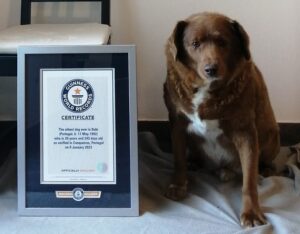
• Bobi, a dog in Portugal born in 1992, has set a Guinness record as the world’s oldest dog at more than 30 years old. Bobi has some mobility issues, and his eyesight is declining, but his owner says he still enjoys playing with the four cats with which he shares his home
• The SDF stated “ We are heartbroken to witness the widespread destruction throughout Turkey, Syria and the surrounding region caused by a massive 7.8 magnitude earthquake. Our thoughts are with all those affected as rescuers respond to join the search efforts.”

“Seven canine disaster search teams trained by SDF have deployed alongside rescue teams from around the world in response to the earthquake and we send our deepest gratitude to all the two- and four-legged rescuers that answered the call for help.”
National Disaster Search Dog Foundation
6800 Wheeler Canyon Road
Santa Paula (it seems like Ventura)
•Lee Pickett, VMD, practices companion animal medicine in North Carolina.
Q: I adopted a pit bull who had lost one ear in the fighting ring, so I named him Van Gogh. He is a healthy, sweet, gentle guy who loves to snuggle. When we lie on the couch watching television and my arm drapes across his chest, I sometimes notice that his heart beats in an unsteady rhythm.
It beats fast for a few seconds, then slowly for a few seconds, and then the cycle repeats. I am concerned that Van Gogh may have heart disease because he is relaxed and unstressed when I feel this irregular heart rhythm. Should I take him to his veterinarian or a veterinary cardiologist?
A: Without examining Van Gogh, I can’t say for sure. But my guess is that when he is calm, he develops respiratory sinus arrhythmia, a normal condition that commonly occurs when a dog’s heart rate decreases with relaxation.
Not all arrhythmias, or irregular heart rhythms, indicate heart disease. In respiratory sinus arrhythmia, the heart rate quickens during inspiration and slows when the dog exhales and pauses between breaths. The term “sinus” refers not to the nose but to the sinoatrial node, also called the sinus node, the heart’s natural pacemaker located in the right atrium.
To convince yourself that Van Gogh’s changes in heart rhythm constitute the normal sinus arrhythmia that occurs when a dog is relaxed, take him for a run. While his heart rate is still elevated from the exertion, feel his chest. You should feel steady, evenly spaced heartbeats.
There’s an adage in veterinary medicine that “cats are not small dogs,” because the two species differ in significant ways. This is but one example. When a cat relaxes, the heart continues to beat in a steady pattern. Any arrhythmia, even a respiratory sinus arrhythmia, is abnormal in a cat.
If you are in doubt about Van Gogh’s arrhythmia, ask his regular veterinarian to listen to his heart and perhaps perform an electrocardiogram, or ECG.
• Cats have a better quality of life if you play with them
By Andrei Ionescu
Earth.com staff writer
Scientists have long argued that play is an indicator and promotor of animal health and welfare. Now, by applying in-depth empirical methods to analyze data gathered from around the world, a team of researchers led by the University of Adelaide in Australia has found that playing with your cat can also nurture closer human-cat bonds.
To investigate play-related factors associated with welfare in cats, the scientists devised an online survey in consultation with veterinarians, animal behaviorists, and cat owners, aiming to measure factors such as cat quality of life, cat-owner relationship quality, behavioral changes, and problem behavior prevalence.
“Our survey results, based on responses from 591 cat guardians from 55 countries, indicated greater cat playfulness and more types of games played were significantly associated with better cat quality of life,” said study lead author Julia Henning, a PhD student in Feline Behavior at Adelaide.
“Also, longer amounts of daily play, greater number of games, both cat and guardian initiating play, and heightened guardian playfulness were also associated with better quality cat-guardian relationships.”
Moreover, exclusive indoor housing for the cats was significantly linked with both increased cat quality of life and better cat-owner relationship in comparison to cats with outdoor access. “Behavioral changes that indicated stress, frustration, or unease were reported when play was absent. Therefore, we can conclude play may be a very important factor in assessing and maintaining cat welfare,” Henning explained.
However, as senior author Susan Hazel (an expert in Animal Behavior and Welfare at the same university) admitted, self-reporting surveys such as this often have significant limitations. “Cat lovers’ answers may be prone to respondent and recall bias and limited in their ability to assess behavior. Participants who dedicated their time and effort on a voluntary basis are more invested in their cat’s care than the average cat guardian. Therefore, responses may not be an accurate representation of the general population.”
Further research is needed to clarify how much and what kind of play is most efficient for improving cat welfare.
The study is published in the journal Animal Welfare.
